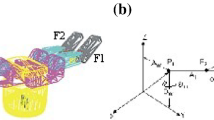Abstract
In this paper the authors introduce the conformal geometric algebra in the field of visually guided robotics. This mathematical system keeps our intuitions and insight of the geometry of the problem at hand and it helps us to reduce considerably the computational burden of the problems.
As opposite to the standard projective geometry, in conformal geometric algebra we can deal simultaneously with incidence algebra operations (meet and join) and conformal transformations represented effectively using spinors. In this regard, this framework appears promising for dealing with kinematics, dynamics and projective geometry problems without the need to resort to different mathematical systems (as most current approaches do). This paper presents real tasks of perception and action, treated in a very elegant and efficient way: body–eye calibration, 3D reconstruction and robot navigation, the computation of 3D kinematics of a robot arm in terms of spheres, visually guided 3D object grasping making use of the directed distance and intersections of lines, planes and spheres both involving conformal transformations. We strongly believe that the framework of conformal geometric algebra can be, in general, of great advantage for applications using stereo vision, range data, laser, omnidirectional and odometry based systems.
Similar content being viewed by others
References
E. Bayro-Corrochano, Geometric Computing for Perception Action Systems, Springer Verlag: Boston, 2001.
E. Bayro-Corrochano, K. Daniilidis, and G. Sommer, “Motor algebra for 3D kinematics. The case of the hand-eye calibration,” Journal of Mathematical Imaging and Vision, Vol. 13, pp. 79–99, 2000.
E. Bayro-Corrochano and J. Lasenby, “Object modelling and motion analysis using Clifford algebra,” in Proceedings of Europe-China Workshop on Geometric Modeling and Invariants for Computer Vision, Roger Mohr and Wu Chengke (Eds.), Xi'an, China, April 27–29, 1995. pp. 143–149,
E. Bayro-Corrochano, J. Lasenby, and G. Sommer, Geometric algebra: A framework for computing point and line correspondences and projective structure using n-uncalibrated cameras,” in Proceedings of the International Conference on Pattern Recognition (ICPR'96), Vienna, August 1996, Vol. I, pp. 393–397.
G. Csurka and O. Faugeras, “Computing three dimensional project invariants from a pair of images using the Grassmann-Cayley algebra,” Journal of Image and Vision Computing,
D. Hestenes, Space-Time Algebra, Gordon and Breach, 1966.
D. Hestenes, “Old wine in new botles: A new algebraic framework for computational geometry,” in Advances in Geometric Algebra with Applications in Science and Engineering, E. Bayro-Corrochano and G. Sobczyk (Eds.), Birkhauser: Boston, Chap. 1, pp. 1–25, 2001.
D. Hestenes, H. Li, and A. Rockwood, “New algebraic tools for classical geometry,” in Geometric Computing with Clifford Algebra, G. Sommer (Ed.). Springer-Verlag: Berlin Heidelberg, Chap.I, pp. 3–23, 2001.
D. Hestenes and G. Sobczyk, Clifford Algebra to Geometric Calculus: A Unified Language for Mathematics and Physics,” D. Reidel: Dordrecht, 1984.
D. Hestenes, and R. Ziegler, “Projective geometry with Clifford algebra,” Acta Applicandae Mathematicae, Vol. 23, pp. 25–63, 1991.
J. Laseby and E. Bayro-Corrochano, “Analysis and computation of projective invariants from multiple views in the geometric algebra framework,” in Special Issue on Invariants for Pattern Recognition and Classification, M.A. Rodrigues (Ed.). Int. Journal of Pattern Recognition and Artificial Intelligence, Vol. 13, No. 8, pp. 1105–1121, 1999.
J. Lasenby, A.N. Lasenby, C.J.L. Doran, and W.J. Fitzgerald, “New geometric methods for computer vision—an application to structure and motion estimation,” International Journal of Computer Vision, Vol. 26, No. 3, pp. 191–213, 1998.
N. White, “Geometric applications of the Grassman-Cayley algebra,” in Handbook of Discrete and Computational Geometry, J.E. Goodman and J. O'Rourke (Eds.), CRC Press: Florida, 1997.
Author information
Authors and Affiliations
Additional information
Eduardo Jose Bayro-Corrochano gained his Ph.D. in Cognitive Computer Science in 1993 from the University of Wales at Cardiff. From 1995 to 1999 he has been Researcher and Lecturer at the Institute for Computer Science, Christian Albrechts University, Kiel, Germany, working on applications of geometric Clifford algebra to cognitive systems.
His current research interest focuses on geometric methods for artificial perception and action systems. It includes geometric neural networks, visually guidevsd robotics, color image processing, Lie bivector algebras for early vision and robot maneuvering. He is editor and author of the following books: Geometric Computing for Perception Action Systems, E. Bayro-Corrochano, Springer Verlag, 2001; Geometric Algebra with Applications in Science and Engineering, E. Bayro-Corrochano and G. Sobczyk (Eds.), Birkahauser 2001; Handbook of Computational Geometry for Pattern Recognition, Computer Vision, Neurocomputing and Robotics, E. Bayro-Corrochano, Springer Verlag, 2005. He authored more than 90 strictly reviewed papers.
Leo Hendrick Reyes-Lozano received his degree in Computer Engineering from the University of Guadalajara in 1999. He earned his MSc. and Ph.D. from the Center of Research and Advanced Studies (CINVESTAV) Guadalajara in 2001 and 2004, respectively. His research interests include Computer Vision, Geometric Algebra and Computer Graphics.
Julio Zamora-Esquivel received his degree in Electronic Engineering at the Guzman City Institute of Tecnology in 2000. He earned his MSc. at the Center of Research and Advanced Studies (CINVESTAV) in Guadalajara in 2003. He is currently a Ph.D Candidate at CINVESTAV. His research interests include Computer Vision, Geometric Algebra and Robotics.
Rights and permissions
About this article
Cite this article
Bayro-Corrochano, E., Reyes-Lozano, L. & Zamora-Esquivel, J. Conformal Geometric Algebra for Robotic Vision. J Math Imaging Vis 24, 55–81 (2006). https://doi.org/10.1007/s10851-005-3615-1
Published:
Issue Date:
DOI: https://doi.org/10.1007/s10851-005-3615-1



